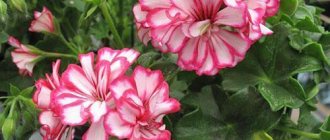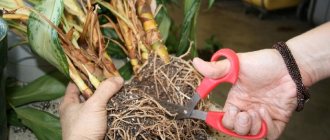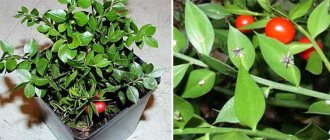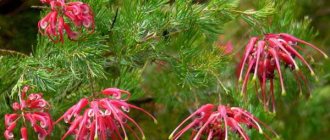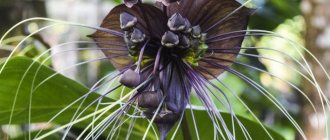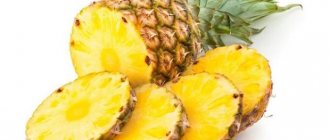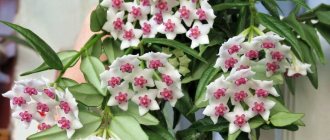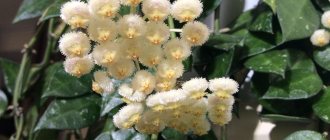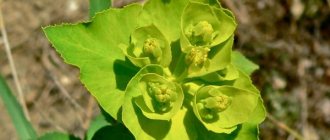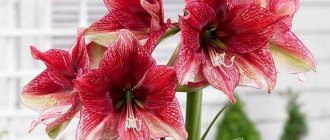Polyscias is a prominent representative of the Araliceae family. The plant was brought to us from the rainforests of tropical Asia. It is an evergreen tree with decorative leaves, for which its various varieties are valued. In our climate, polyscias can only be grown as a houseplant. Caring for polyscias at home can be fraught with some difficulties, but in this article we will analyze them all, which will greatly simplify your task.
Brief description of cultivation
- Bloom . Grown as an ornamental foliage plant. Does not bloom indoors.
- Illumination . Green-leaved species grow in slight shade, while variegated ones grow in bright, diffused light.
- Temperature regime . In winter - from 17 to 20 degrees, during the growing season - from 20 to 23 degrees.
- Watering . During the spring-summer period, water the bush frequently, but moderately, immediately after the top layer of soil mixture in the pot has dried. And in winter, watering is reduced and carried out only after two or three days have passed after the top layer of the soil mixture has dried.
- Air humidity . She must be tall. Therefore, it is recommended to place the pot with the plant on a tray filled with wet pebbles, or it is necessary to systematically moisten the plant with a spray bottle.
- Fertilizer . Fertilizing is carried out in April–October twice a month, for this purpose they use mineral fertilizer for decorative deciduous plants. Moreover, from October to April, polyscias is fertilized half as often (once a month).
- Rest period . It is not pronounced, but in winter the flower grows more slowly.
- Transplant . In the last days of March or in the first days of April. While the bush is young, it is replanted regularly once a year. An older plant is replanted once every 2 or 3 years.
- Reproduction . By seeds, but much more often by apical or stem cuttings.
- Disease . Root rot.
- Pests . Aphids, root nematodes, scale insects and mealybugs.
Helmet-shaped
Polyscias helmet-shaped - characterized by rapid growth compared to other varieties. The leaves are initially round and single - but as they mature, they split into three separate lobes-petals. Young branches are often facing vertically, erect, and the trunk is quite thick and somewhat curved. The species needs timely formative pruning to curb the riot of flower growth. You can see what the Poliscias Helmet-shaped variety looks like in the photo below:
Poliscias helmeted
Features of polyscias
The branched system of polyscias roots grows both horizontally and vertically. The heavily branching stems are covered with brownish bark. Over time, they become lignified, but they still remain very flexible: the stems are extremely difficult to break, but they can be tied into a knot and then straightened. As it grows, the lower part of the bush becomes exposed. Alternately arranged short-petioled leaf plates are painted in a rich or pale green color; they are round, lobed, triply pinnate or paired-pinnate, simply glossy or leathery. Polyscias has variegated varieties that are very popular among gardeners. While the bush is young, its foliage, as a rule, has a simple shape, but over the years it divides into segments. During flowering, inflorescences are formed on the bush, having a capitate or umbrella shape. But when cultivated indoors, such a plant blooms extremely rarely.
What is polyscias?!? )))) Poliscias fabian. Aralia fabian. My departure
General information
The genus Polyscias includes about a hundred species. The closest relatives are considered to be ivies, as well as Fatsia with its numerous hybrids. In indoor culture, plants look like trees or bushes with branched trunks. And the stems have a vertical orientation.
The leaves have the greatest decorative value. They amaze with their variety of shapes. There are simple oval leaves with spots or streaks. But the real wonders of nature include feathery specimens. Their leaves are deep green in color, as if carved by the hands of a skilled craftsman. Complex segments evoke different associations. Some species are similar to carrot or parsley leaves, others are similar to Nephrolepis and Adiantum, and still others resemble oak leaves.
Caring for polyscias at home
Illumination
Poliscias, growing both in nature and at home, needs bright, diffused light. Moreover, it needs a large amount of light both in the warm season and in winter. This flower grows well even in slight shade. When choosing a location, it should be taken into account that green-leaved species grow normally in light partial shade, however, varieties with variegated foliage need a lot of light to maintain their bright color.
Temperature
This flower grows best during the growing season at an air temperature of 20 to 23 degrees. In winter, it is recommended to move the bush to a cooler place (from 17 to 20 degrees), which is located away from operating heating devices.
If the plant is on a windowsill, then polystyrene foam should be placed under the container, which will protect the roots from hypothermia. And to protect the bush from the flow of hot air that rises from the radiator, use plastic or glass.
Remember that such a plant reacts extremely negatively to stale air, so the room where it is located must be ventilated regularly all year round. But at the same time protect it from drafts.
Watering and air humidity
Moisten the soil mixture in the pot moderately, but often immediately after its top layer dries. In the cold season, when the surface of the substrate in the container dries out, wait another two or three days and only then water.
The flower needs a high level of air humidity, so it needs to be systematically moistened with a sprayer. For watering and spraying, use well-settled water, the temperature of which should be slightly above room temperature. To soften hard water, mix it with a few crystals of citric acid or drops of lemon juice. In order to increase the level of air humidity, open vessels filled with water are placed near the flower. Instead, you can take a tray filled with wet expanded clay or pebbles and place the flower pot with polyscias on it, but make sure that the bottom does not come into contact with the liquid. If you have an aquarium in your room, then place a flower near it. Experts advise systematically washing the foliage under a warm shower.
Top dressing
In April–October, fertilizer is applied to the substrate once every 15 days. To feed this flower, use mineral fertilizer for decorative deciduous indoor plants. At the same time, from October to April, polyscias is also regularly fed, but once every 30 days. You can also use ready-made organic solutions for fertilizing; they can be purchased at a specialized store.
Polyscias transplant
While the bush is young, it is replanted systematically once a year, and older specimens - once every 2 or 3 years. An excellent time for replanting is early spring, the beginning of the growing season. The soil mixture suitable for replanting consists of humus, coarse river sand, peat, leaf and turf soil.
At the bottom of the new pot, first make a good drainage layer; for this, take fragments of clay shards or expanded clay. For replanting, use the transshipment method; first moisten the bush generously, in this case it will be much easier to pull it out of the pot, while preserving a whole lump of earth on the root system. Transplant the flower into a new container, and fill all the empty space with the prepared soil mixture. Water the transplanted bush well and exclude any fertilizing for at least 30 days.
In a bush that has begun to grow intensively, the stems are pinched to stimulate branching. Polyscias is perfect for growing hydroponically.
Soil requirements
Our gardeners grow polyscias in rather difficult soil with good drainage from expanded clay or small fragments of bricks. So, the ground:
- One part of soil from rotted leaves (leaf soil). It will be an ideal leavening agent and will allow the roots of the plant to breathe well.
- One part of turf soil. If you decide to grow polyscias, then most likely you are such a keen gardener that you have such soil. Soddy soil is obtained as follows: in the spring, 10 cm of turf is removed from the top layer of a piece of unplowed land and laid with the grass down, 10 cm of rotted manure on it, again a piece of turf with the grass down on it, another layer of rotted manure on it, and so on. 3-4 layers. All summer this layer cake needs to be watered, not allowing it to dry out, and its ends need to be somehow protected from weathering, for example, by placing boards. During the summer and autumn it is necessary to dig up this structure twice with a shovel. By winter we will have turfy soil.
- One part of humus.
- One part peat.
- One piece of pure small river stove.
Reproduction methods
Cuttings
As a rule, apical or stem cuttings are used to propagate indoor polyscias. Many plants can be propagated by cuttings quite easily, but not polyscias. The fact is that if everything is done correctly, the roots on the cuttings can grow, but it will take a very long time. After suitable cuttings are cut, the cut areas are sprinkled with charcoal crushed to a powdery state. Let the cuttings dry at room temperature and only then plant the cuttings for rooting. To do this, they are planted in a mixture of coarse sand and peat (1:1), on top they should be covered with a transparent cap (for example, a bag or glass jar), in this case it will be much easier to maintain the high level of air humidity necessary for rooting.
Place the container with the cuttings in a warm place (about 25 degrees), do not forget to regularly ventilate in the morning and evening, if necessary, moisten the cuttings with a spray bottle and water them. They will take root for at least 30 days.
Curly
Polyscias curly is a low-growing hybrid, the shoots of which are almost completely covered with leaves. Depending on the mutation, the leaves are round, cut in two or three, the color is dark green, rich. The foliage is leathery and quite thick, sometimes with a decorative yellow border, spots or dashes. Prized for its variegated color and very pretty leafy branches that create the illusion of a tropical mini-tree. The photo below shows Poliscias Curly:
Poliscias curly
Pests and diseases of polyscias
Diseases
Polyscias grown at home only gets sick if it is not cared for properly. For example, if the air humidity in the room is excessively low, then the edges of the leaf plates will turn brown and they will begin to fly around. Also, the fall of leaves on a bush may be due to drafts or excessively high air temperatures. In some cases, leaves may begin to fly away because the plant is aging and this is a completely natural process that should not cause concern.
Polyscias is highly resistant to infectious diseases, however, if water systematically stagnates in the substrate, then the roots may rot. What to do in this case? Remove the flower from the container and remove all the soil mixture from its root system. Cut out all rotten areas with a sharp, sterilized instrument, while capturing a small part of healthy tissue. Sprinkle the cut areas with charcoal powder and plant the bush in a new soil mixture. At first, it is recommended to use a pinkish solution of potassium permanganate or a solution of Fundazol to water it. They do this until the bush becomes completely healthy.
Pests
Aphids, scale insects or mealybugs can settle on a recently transplanted or very weak bush. All these pests are sucking, they pierce young shoots and foliage and suck out the plant sap from them. To combat harmful insects, use a solution of any suitable insecticide, but immediately before treatment, remove scale insects or scale insects from the bush using a cotton swab moistened with alcohol. After this, the bush is thoroughly washed under a warm shower and only when it is thoroughly dry, it is sprayed with a solution of Actellik, Fitoverm, Aktara, Decis or another insecticidal agent of similar action.
Quite rarely, root nematodes settle on such a plant, which is why its development and growth become very slow. The bush begins to wither and dies after some time. It is impossible to get rid of such a pest, which is why cut cuttings from the bush for rooting, and destroy it along with the substrate.
Benefit or harm?
One of the most unpleasant properties of polyscias is its toxicity. Its juice can cause chemical burns; contact with the skin, mucous membranes, or eyes is unacceptable. When pruning and caring for the plant, you should wear work gloves, and wash your hands thoroughly with soap after each procedure.
At the same time, the plant looks beautiful, unusual, and can decorate any home, and a few pieces turn the room into something like a “corner of the tropics.” This perennial shrub is a suitable candidate for growing into a bonsai - a dwarf tree, the cultivation of which is an interesting and exciting hobby.
Types and varieties of polyscias with photos and names
Below we will describe those types and varieties of polyscias that are most popular among gardeners.
Polyscias scutellaria
This shrub-type evergreen plant has a curved main trunk (like a bonsai) and thin, erect side branches. This plant has many glossy whole leaf plates, colored green and with a white edge. Young leaves are round, but over time they become three times dissected. The most widely distributed variety in cultivation is Marginata: the edge of the green leaf blades is decorated with small teeth and a wider white border.
Polyscias crispatum
This species forms not very tall bushes, its stems are completely covered with foliage. The rich green leaves have a white edge. While the leaf blades are young, they have a rounded shape, but as they age, it changes to twice or thrice dissected, and yellow spots may appear on the surface. The best varieties:
- Palapala - green foliage is decorated with yellow spots;
- Raffles - such a flexible bush with green foliage is used to create bonsai.
Polyscias fruticosa
This species differs from all others cultivated at home in its highly decorative nature; in appearance it looks like a fern. On the surface of young stems there are convex lentils. Vaginal double- or triple-pinnate leaf plates consist of leaflets with toothed-serrate edges, the shape of which can vary from lanceolate to round. During flowering, apical inflorescences appear, consisting of unattractive small flowers. The best varieties:
- Multifida - leaf blades consist of many linear or linear-lanceolate segments, which end with light-colored villi;
- Filigree - lacy foliage finely dissected;
- Snow Flake - a white border runs along the edge of the coarse-toothed leaf plates.
Polyscias balfouriana
Or polyscias balfuoriana. This evergreen plant does not branch very much, and it reaches a height of about 150 cm. The dark green long-petioled leaf plates are lobed, pinnately dissected, almost round, and reach about 70 mm in diameter. Along the edge of the plate there is a border and white spots. Popular varieties:
- Fabian - dark purple foliage color;
- Pennockii - the foliage of this plant is larger than the main species, it is greenish-gray and decorated with silver veins;
- Variegata - along the edge of the leaf blades there is an uneven border of whitish color.
Polyscias obtusa
The complex leaf blades include three-lobed, rounded leaves that are shaped like oak foliage. Because of this, this species is often called “Oak Leaf” in foreign literature.
Polyscias filicifolia
This shrub, which is evergreen, has long, pinnately dissected green leaf blades that are similar to the fronds of a fern. The length of the foliage varies from 0.3 to 0.5 m, while its lobes are densely spaced.
Polyscias paniculata
This low-growing shrub is decorated with lush, pinnately dissected foliage of a greenish color, which reaches a length of 15 to 20 centimeters. A widespread variety is Variegata: along the edge of the foliage there is a thin border of a golden hue.
Polyscias guilfoylei
This species is very popular among gardeners. This branched shrub has unpaired-pinnately complex large leaf plates, which consist of green leaves of a lanceolate-oval shape with a serrated edge and bordered with a yellow or white stripe. The best varieties:
- Variegata - foliage is greenish-yellow;
- Victoria - small greenish-white foliage heavily cut along the edges;
- Black - wrinkled foliage of dark green color;
- Smooth Black - smooth leaf blades have a very dark color.
Bonsai Poliscias
3.Varieties:
3.1.Polyscias scutellaria
Beautiful plant
An evergreen branched shrub or small tree with a height of 1 to 6 m. At home, it is often grown as an ornamental deciduous plant in the bonsai style. The plant has green, glossy, rounded leaves with branched veins, on long petioles. The lower surface of the leaf blades and the part of the leaf near large veins is often colored burgundy. The leaves are arranged alternately. The trunks of the bush are covered with light brown smooth bark.
3.2.Polyscias scutellaria 'Fabian'
An attractive evergreen, multi-stemmed shrub with erect shoots abundantly branched at the base. With age, the shoots become woody and covered with light brown bark. The plant is abundantly covered with dark green, glossy, rounded leaves on long petioles up to 5 cm in diameter.
3.3.Polyscias fruticosa
An aerial evergreen perennial that can grow either as a shrub or a small tree 1–2 m high. The leaves are light green, palmately dissected, on long, flexible petioles. The leaf fingers have large teeth along the edges. Some plants have complex leaves, consisting of several oblong-lanceolate, coarsely toothed segments.
3.4.Polyscias filicifolia
Spectacular decorative deciduous evergreen shrubs with a height of 180 to 250 cm. The plants have green, abundantly branched shoots, which become woody with age and are covered with brown bark. The leaves are delicate, lacy, pinnately dissected or compound - consisting of several linear segments. Shades of leaf blades include a wide range of green colors, the edges of the leaf blades often have large teeth. The leaf petioles are long, curved, and thin. The surface of the leaves is glossy.
3.5.Polyscias balfouriana
Evergreen plants, in their natural habitat reaching a height of 4 - 5 m. These decorative deciduous shrubs have powerful, abundantly branched stems covered with light brown bark. The leaves are arranged alternately, on long, thin petioles. The leaf blades are round in shape with uneven teeth along the edge, dark green, glossy. Young leaves that have just appeared often have a lighter shade. There are variegated varieties with white or light green stripes along the edges of the leaf blades. With age, this species may lose its lower leaves and expose the trunk, but this only gives it additional attractiveness.
You might also be interested in:
Fatsia
Spathiphyllum
Radermacher
Streptocarpus
Shrubby
Polyscias shrubby is also called the fructose variety. Thanks to its sophisticated, elegant shoots, it has earned a certain popularity among flower growers. The bush is very compact, the leaves can be either dissected and thin, similar to ferns, or monocotyledonous. There are hybrids that can grow several types of leaves on one plant at once. Able to withstand shading and interruptions in watering, in the tropics it can grow into a three-meter bush - but at home it grows as a very small and modest flower. In the photo below is the Poliscias Bush variety:
Poliscias shrubby
Balfour
Balfour polyscias is a shrub with elegant greenish-gray bark, characterized by low growth and three-segmented leaves up to seven centimeters long. Together they look round or semi-circular, the color varies from variety to variety - variegated with a border or carved patterns, or emerald green, with pronounced veins.
Balfour Poliscias
Photo gallery
This is a light-loving crop; for keeping it, it is advisable to choose places with long-term diffused light. Even with quality care it grows slowly, but is a real long-liver. He can feel comfortable in an apartment for more than 10–15 years.
Outwardly it resembles small-leaved varieties of ficus, but has lush vegetation and a medium-thick trunk. The juice in the leaves does not contain toxic substances; the flower is suitable for growing in a home with small children and pets. The price for polyscias varies from 2 to 8 thousand rubles, depending on the age and variety.
fern-leaved
Polyscias fernifolia, also called the philosophy variety, is a bushy evergreen plant, the branches of which are quite spreading and lush. They are strewn with large openwork light green leaves of a bizarre branching fractal shape. The leaves fit very tightly and closely on the trunk, making the entire bush look like a fern. The leaves are almost perfectly outlined and have the appearance of a fractal figure, repeating its outline both in small details and throughout the entire leaf.
Poliscias fernifolia
Holly
The holly variety Polyscias looks completely different. Its elongated and thin leaves are openwork and carved, most reminiscent of fern or daisy leaves, but many times larger. The beautiful fluffy shape and variegated color of some varieties makes it quite hardy and resistant to wind or slight drought. But unlike other varieties, its leaf blades do not have a fractal repetition of the pattern; the central vein only bears branching leaf blades-lobes.
Poliscias aculifolia
Paniculate
Polyscias paniculata is distinguished by pinnate, carved and rather flattened leaf blades. The color can be either plain matte green with a tint of khaki or rich dark jade, or variegated, with uniform repeating patterns or torn spots of light and dark shades. This species is sensitive to light - too much light makes the leaves pale, obscuring the pattern - while too little light leads to thick and dark color.
Poliscias paniculata
Watering
When growing polyscias, regular and moderate watering is required as the top layer of soil dries. The plant reacts negatively to both drying and waterlogging. The water should be soft and settled, which allows you to get rid of chlorine impurities that are dangerous to the flower.
Before watering, it is recommended to warm it up 1–3 °C above room temperature. In winter, the soil is moistened as needed, and the frequency and volume of watering is reduced to a minimum. Polyscias is not sprayed.
If you are going on vacation
Poliscias does not tolerate a lack of moisture; if you are leaving for a long time, it is advisable to provide the flower with the necessary water. To do this, it should be watered generously immediately before leaving.
Additionally, you can pour a little water into the tray. Next to the plant you can place a container with soft water or generously moistened pebbles or expanded clay. If possible, it is advisable to give the flower to friends or relatives to avoid unpleasant consequences.
